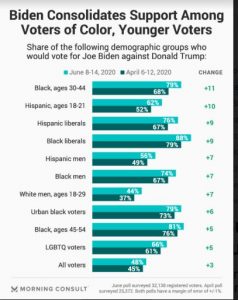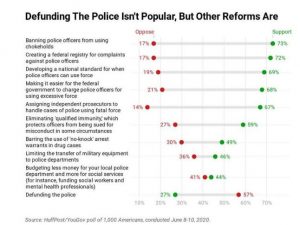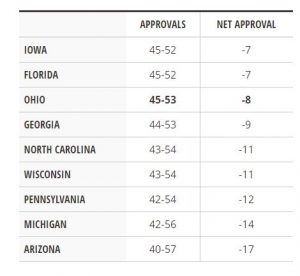The Democrats have a nominee for the U.S. Senate seat in Georgia now occupied by Republican Sen. David Perdue. As Greg Bluestein reports at The Atlanta Journal-Constitution: “Jon Ossoff captured the Democratic nomination for the U.S. Senate on Tuesday, emerging from a crowded field that included two well-financed rivals to win an outright victory in the race to challenge U.S. Sen. David Perdue…Ossoff, 33, notched a clear win that eluded him three years ago when he waged a special election campaign for a suburban Atlanta congressional district that earned national attention..His victory comes after a primary marred by long lines, equipment malfunctions and missing absentee ballots that put the state’s voting problems in the national spotlight…Ossoff’s victory was called by The Associated Press as absentee ballots from metro Atlanta, his biggest base of support, steadily boosted his vote total above the 50% mark.” His message: “This is not a moment to let up. This is a moment to double down,” said Ossoff, who owns an investigative journalism firm. “We can no longer go down a path of authoritarianism, of racism, of corruption. We are better than this…“I expose corruption for a living,” he said at a forum, “and David Perdue sells access for campaign cash.”
Bluestein continues, “The coronavirus pandemic may have helped his campaign, too. All three candidates were forced to resort to virtual campaigning as restrictions took hold in March, but analysts said it could give candidates with high profiles and deep pockets an edge since old-fashioned retail politicking was largely off-limits…Armed with the endorsements of U.S. Reps. Hank Johnson and John Lewis — veteran Democrats he considers mentors — Ossoff has embraced left-leaning policies he didn’t emphasize during his 2017 campaign…Ossoff has talked often about deep racial inequities that shape every facet of American life, and he’s promised to fight for stronger civil rights protections, an end to mandatory minimum prison sentences and a ban on private prisons…One of his recent TV ads invokes the death of Ahmaud Arbery, a 25-year-old shot dead while running near his Brunswick neighborhood, in his push to overhaul the criminal justice system. He’s called the pandemic a “massive wake-up call” to expand health insurance and bolster public health funding.”
Ossoff had the endorsement of Rep. John Lewis, and he hopes to build a broad electoral coalition to win the seat. African Americans are nearly 1/3 of Georgia’s eligible voters. So it’s possible that Ossoff could win in November with 2 out of 7 white voters. Stacy Abrams, the Democratic candidate for Governor in 2018, has mobilized an energetic campaign against voter suppression, and if her efforts produce an increase in Black voter turnout, Ossoff could benefit. Georgia’s other senate seat, now occupied by Republican appointee Kelly Loeffler, will also be on the ballot in a special election. Voters will chose from a long list of candidates on the ballot, with party identifiers by their names. If no candidate receives more than 50% of the vote, the top two finishers will advance to a runoff election on January 5, 2021. Both Republican incumbent senators are facing tough questions about insider trading and profiteering from the coronavirus pandemic.
At Newsweek, James Walker reports that “Donald Trump’s Economic Approval Rating Falls Below 50 Percent for First Time in Over Two Years.” Walker writes, “The latest presidential approval poll, published by Gallup on Wednesday, found that 47 percent of U.S. adults approved of the president’s record on the economy…When the same poll was conducted in January, Trump’s economy approval rating was 16 points higher—standing at 63 percent…The last time the president had an economic approval rating below 50 percent was in November 2017, when Gallup found only 45 percent of U.S. adults backed his record on the issue…In the pollster’s latest survey, 51 percent of respondents said they disapproved of the president’s handling of the economy—a level also unseen since Gallup’s November 2017 poll…Asked for their overall opinion of Trump’s performance in the Oval Office thus far, less than four in ten (39 percent) said they approved. Fifty-seven percent of surveyed Americans said they disapproved of the president’s record in office…The current unemployment rate exceeds anything seen since the Great Depression, when roughly a quarter of the working population was out of a job.”
John Cassidy explains why “Why the Polls Are Alarming for Donald Trump” at The New Yorker: “Here are some bad signs for Trump that struck me after I spent some time burrowing into the invaluable polling databases that are maintained by RealClearPolitics and FiveThirtyEight…In the past two months, Trump hasn’t led in a single national poll. The FiveThirtyEight general-election database contains the results of hundreds of surveys, and the last one showing Trump in front of Biden nationally was conducted by Change Research on April 2nd and 3rd—a moment at which Bernie Sanders was still contesting the Democratic primary. Back in 2016, Trump trailed Hillary Clinton in the vast majority of national surveys, too. But, during the two-month period from April 9th to June 9th of that year, he led in five of them, including a poll in May from ABC News/Washington Post that got quite a bit of attention. Since early April of this year, every single national poll in the FiveThirtyEight database, including some that tend to lean Republican, has shown Biden ahead.”
Cassidy adds, “Polls from key states are also pointing to trouble for Trump. The R.C.P. database lists thirteen states as battlegrounds: Arizona, Florida, Iowa, Michigan, Minnesota, Nevada, New Hampshire, North Carolina, Ohio, Pennsylvania, Texas, Virginia, and Wisconsin. According to R.C.P.’s poll averages, Trump is leading in just three of these states—Iowa, North Carolina, and Texas—and only in Iowa is his advantage more than three percentage points. In Arizona, Florida, and Ohio, all of which Trump carried in 2016, Biden is slightly ahead. And in Michigan, which was another linchpin of Trump’s 2016 victory in the Electoral College, a new poll released on Monday showed Biden doubling his lead, to twelve points, compared with a survey that the same pollster, EPIC-MRA, took in January…Finally, compared with this point in 2016, Biden is much less unpopular than Clinton was.” Hoever, “Biden’s polling lead in Pennsylvania and Wisconsin—two of the Rust Belt states that ensured Trump’s Electoral College victory in 2016—is small: 3.3 percentage points and 3.4 percentage points, respectively, according to the R.C.P. averages.”
At The Boston Review, professor Jocelyn Simonson shares some insights regarding “Power Over Policing,” which Democratic candidates may find helpful in honing their messaging. Simonson notes that “There is a distressing disconnect between the ringing demands for justice on the streets and the suite of “police reform” proposals that many experts say satisfy these demands. Protesters and social movements talk about divesting from policing and investing in black communities. They talk about ensuring that “the most impacted in our communities need to control the laws, institutions, and policies that are meant to serve us,” as the Movement for Black Lives stated in its list of demands this week. The call is for stability, resources, control. The call is for power.” Further, “expert explications of the gold standard methods of “reforming police departments” focus on how to increase the efficiency and decrease the harmfulness of existing police forces. They emphasize measurable “success” in police reform: either instrumentally focusing on the “costs” and “benefits” of particular police tactics or seeking out “legitimacy” and cooperation between law enforcement and communities.”
In his article, “Biden: The 21st-Century FDR?” Harold Meyerson writes at The American Prospect that “the president who Biden now hopes to model himself on isn’t so much Lincoln as it is Franklin Roosevelt—specifically, the FDR who tilted public policy in favor of workers and a more and better managed capitalism…If Biden is serious about initiating the huge economic reforms and the economic recovery the country so manifestly needs, not to mention the reforms required to move us toward more actual, more lived racial equality, he’ll need to rely on advisers who aren’t the 21st-century versions of Douglas and Morgenthau—who aren’t, in short, Summers and Emanuel. He shouldn’t take my word for it; he should ask what would Roosevelt and Lincoln do?”
“Biden, by most accounts, has been a different man since the pandemic hit,” Michale Tomasky writes at The New York Review of Books. “Last year, he sometimes spoke of his presidency as a return to a pre-Trump era. Now, with unemployment nearing 15 percent and calls for change from protesters becoming more urgent—and with the crisis starkly laying bare the economic precarity in which so many Americans were living even before the virus hit—he sees himself in the mold of Franklin Roosevelt, a leader who would rise to the vast challenge history has thrust upon him and introduce sweeping change. The change in Biden has sometimes been overstated. But it is real, and it makes the prospect of a Biden presidency (provided it’s combined with Democratic capture of the Senate) far more intriguing than it was just two months ago…It’s not so much that the virus has moved Biden to the left. Rather, it has nudged reality leftward, and Biden has followed…So Biden’s current shift is probably less a policy shift than a persona shift. But we shouldn’t gainsay the potential importance of persona shifts. They can lead politicians to change their emphasis and their actual priorities.”











